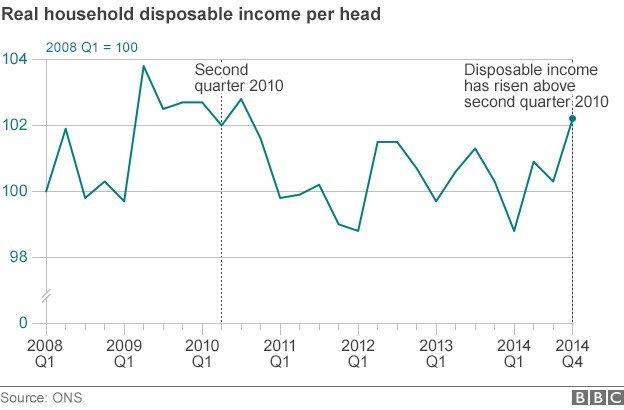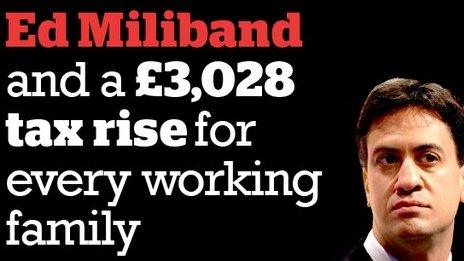Reality Check: Are standards of living rising?
- Published

Speaking on Sky News and Channel 4 last Thursday, Labour leader Ed Miliband said: "Living standards have fallen."
On Tuesday, Chancellor George Osborne said: "Living standards are higher than when we came to office."
Who is right depends on which measure you use - there is no definitive measure of standards of living - but there are some fresh figures out this morning.
The measure that Labour has been using for a very long time is that people are £1,600 a year worse off than they were at the time of the last election.
This figure was a comparison of average weekly earnings adjusted for inflation using the Retail Prices Index, although the people at Full Fact, external point out that it's now changed to median wages adjusted using the Consumer Prices Index, which coincidentally still gives a figure of £1,600.
Anyway, the point is that this only takes into account employed people and also it's a figure from April 2014, which is pretty old. Falling inflation and rising average earnings recently mean that ideally you would want a more up-to-date measure.
And that brings us on to the Office for National Statistics (ONS) Economic Wellbeing, external release for the last three months of 2014, which was published this morning.
It collates 10 indicators, including Mr Osborne's favourite measure of standards of living: Real Household Disposable Income (RHDI) per capita.
In the Budget, Mr Osborne said that RHDI by the end of 2015 would be above the level at the last election.

This morning's figures suggest that RHDI for the last three months of 2014 was just a touch above the figures for the second three months of 2010 (which was when the election was).
But they're still below the levels they were in the previous four quarters, and indeed the figure for the whole of 2014 is still below the whole of 2010.
The ONS has made a few changes to the RHDI measure. It used to include things you would not consider to be households such as charities, universities and trade unions, but they have now been excluded.
The other issue with it is that the average it uses is the mean (add up all the income and divide by the number of households) which means it could be skewed by a small number of very wealthy people.
An alternative measure would be median income (line up all the households in order of income and take the middle one) which is at its lowest level since 2002-03, the ONS says, although that's also quite an old figure, from 2012-13.
The Institute for Fiscal Studies (IFS) predicts, external that the 2014-15 figure will be at about the same level as it was before the recession in 2007-08, but still below its peak in 2009-10.
Most of the other measures have improved since 2010, although as the IFS pointed out after the Budget, taking five years to recover standards of living is a very slow recovery.
Also, while many of the measures have recovered to their 2010 levels, they have not recovered to their 2009 levels. Most of them fell sharply from 2009 to 2011, so while the comparison with the previous election is important politically, economically it is also important to look at the peak in the previous year, and on the whole we're not back to those levels yet.
And interestingly, one of the indicators that has deteriorated the most since 2010 is whether people are satisfied with their income, so perhaps these figures are not as much of a boost for Mr Osborne as he might have hoped.

Election 2015 - Reality Check

What's the truth behind the politicians' claims on the campaign trail? Our experts investigate the facts, and wider stories, behind the soundbites.
Read latest updates or follow us on Twitter @BBCRealityCheck, external

- Published31 March 2015
- Published31 March 2015

- Published30 March 2015
